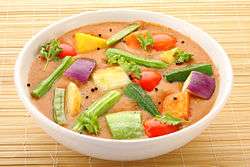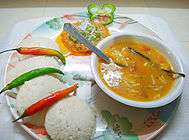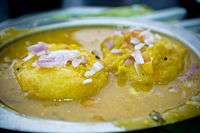Sambar (dish)
 | |
| Type | Stew or chowder |
|---|---|
| Place of origin | India |
| Region or state | South India |
| Main ingredients | Tamarind broth, lentils, vegetables |
|
| |
Sambar, also spelt sambhar, is a lentil-based vegetable stew or chowder based on a broth made with tamarind. It is popular in South Indian and Sri Lankan Tamil cuisines. In malayalam, this dish's name is written as സാമ്പാർ. In tamil, this dish's name is written as சாம்பார்.
Origins
One of the stories is that it originated in the kitchen of Thanjavur Marathas ruler Shahuji during the 17th century from the southern Indian state of Tamil Nadu.[1] Shahuji trying to make a dish called amti, experimented with pigeon peas instead of mung bean, and tamarind pulp for kokum and the court named it sambhar after the guest of the day, Sambhaji, second emperor of the Maratha Empire.[2]
Other sources point to origin as Karnataka where sambaru padartha in Kannada means mix of spices and condiments. There is also an alternate explanation that the origin of the name is from the old Tamil word, chaampu, meaning ground or paste, in the context of grinding coconut and spices to be dissolved in tamarind pulp. This word is also the root for the unrelated South East Asian dish sambol.[3]
Etymology
The word Sambar (old Tamil:Champaar - சாம்பார்) stems from Tamil word Champaaram (சம்பாரம்) meaning spicy condiments. Chambaram kootu (சம்பாரங்கூட்டு) and chambaram podi (சம்பாரப்பொடி) means curry powder.
A Tamil inscription of 1530 CE, evidences the use of the word champaaram, in the sense of meaning a dish of rice accompanying other rice dishes or spice ingredients with which a dish of vegetable rice is cooked:
“அமுதுபடி கறியமுது பல சம்பாரம் நெய்யமுதுள்ப்பட தளிகை ஒன்றுக்கு பணம் ஒன்றாக”
Amuthupadi ka’riyamuthu pala champaaram neyyamuthu’lppada tha’likai on’rukku pa’nam on’raak.
Meaning: “Cooked rice offerings, including curry rice (pepper rice or vegetable rice), many types of spiced rice (pala champaaram) and ghee rice, at the rate of one pa’nam (a denomination of money) per one portion.”
Ka'riyamuthu pala champaaram, as a compound phrase could also mean vegetable rice prepared with many spices.
Preparation

Sambar is made either exclusively with one of these vegetables or a combination of them - okra, moringa (also known as drumstick), carrot, radish, pumpkin, daikon, potatoes, tomatoes, brinjal (eggplant) and whole or halved shallots or onions. Sambar powder is a coarse powder made of roasted lentils, dried whole red chilies, fenugreek seeds, coriander seeds and sometimes asafoetida and curry leaves with regional variations including cumin, black pepper, grated coconut, cinnamon, or other spices.[4] The vegetables, tamarind pulp, sambar powder, turmeric, salt, and asafoetida are boiled together, until the vegetables are half-cooked. After the vegetables are half cooked, the cooked lentils (The most common lentil used is the split pigeon pea also known as Toor Dal) are added and allowed to cook until the vegetables are done. A spice-scented oil is added to the cooked Sambar for extra flavor and tempering, and the dish is served garnished with fresh coriander leaves or curry leaves. The addition of spice-scented oils at the end of cooking for is a common Indian culinary technique. Mustard seeds, black gram, dried red chillies and curry leaves fried in ghee or vegetable oil is one example of numerous oil flavourings used for Sambar.
Variations
Sambar is reflective of a broad and ancient tradition of lentil-based vegetable stews in southern India. In regions that grow coconuts, notably some areas of Kerala, coastal Karnataka and Tamil Nadu, Sambar is made with a paste of fresh, grated and roasted coconuts and spices, instead of sambar powder. Sambar without lentils (but with vegetables/fish/dry fish etc.) is called kuzhambu in Tamil Nadu.
Serving
Sambar is usually served with steamed rice as one of the main courses of both formal and everyday south Indian cuisine. A two-course meal of Sambar mixed with rice and eaten with some sort of vegetable side dish followed by yoghurt mixed with rice is a prime southern Indian staple. Vada sambar and idli sambar are popular for breakfast or evening snack in the south Indian states. Road side restaurants often offer free refills of sambar for iddli and vadas. Sambar is also served as a side dish for dosa.
- Common sambar serving
 Sambar served with idli
Sambar served with idli Vada sambar
Vada sambar Coconut sambar
Coconut sambar
See also
| Wikimedia Commons has media related to Sambar (dish). |
References
- ↑ A wedge of the past, How any of us are aware that in the 18th century Shahaji, the Maratha king of Thanjavur came up with sambar by mixing tamarind curry with lentils and named it in honour of his cousin Sambhaji who was visiting him?
- ↑ The Story of Sambhar
- ↑ "Kamal Haasan, Prakash Raj strengthen 'encyclopaedia' myth on Sambar". 15 April 2013. Retrieved 2014-03-20.
In Eezham Tamil usage, Champal means a paste or ground salad of spices and scrapped coconut. Sambol in Sinhala means the same. The same word is used in the Malay of Malaysia and Indonesia too, to mean a paste of spices served with rice.
- ↑ "Sambar Powder Recipe - Homemade Spice Mix".


